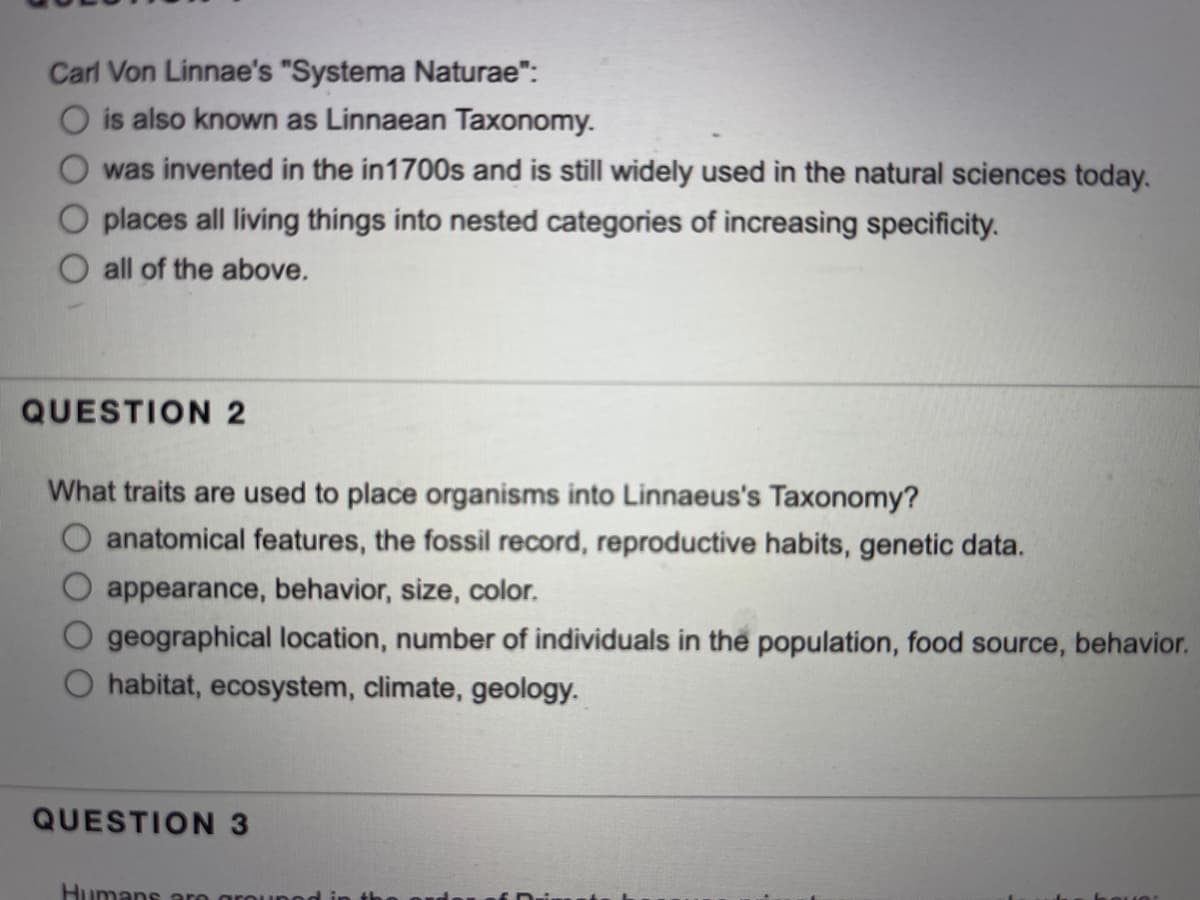Carl Von Linnae's "Systema Naturae": O is also known as Linnaean Taxonomy. was invented in the in1700s and is still widely used in the natural sciences today. places all living things into nested categories of increasing specificity. O all of the above. QUESTION 2 What traits are used to place organisms into Linnaeus's Taxonomy? anatomical features, the fossil record, reproductive habits, genetic data. appearance, behavior, size, color. geographical location, number of individuals in the population, food source, behavior. habitat, ecosystem, climate, geology.
Carl Von Linnae's "Systema Naturae": O is also known as Linnaean Taxonomy. was invented in the in1700s and is still widely used in the natural sciences today. places all living things into nested categories of increasing specificity. O all of the above. QUESTION 2 What traits are used to place organisms into Linnaeus's Taxonomy? anatomical features, the fossil record, reproductive habits, genetic data. appearance, behavior, size, color. geographical location, number of individuals in the population, food source, behavior. habitat, ecosystem, climate, geology.
Human Anatomy & Physiology (11th Edition)
11th Edition
ISBN:9780134580999
Author:Elaine N. Marieb, Katja N. Hoehn
Publisher:Elaine N. Marieb, Katja N. Hoehn
Chapter1: The Human Body: An Orientation
Section: Chapter Questions
Problem 1RQ: The correct sequence of levels forming the structural hierarchy is A. (a) organ, organ system,...
Related questions
Question

Transcribed Image Text:Carl Von Linnae's "Systema Naturae":
O is also known as Linnaean Taxonomy.
was invented in the in1700s and is still widely used in the natural sciences today.
O places all living things into nested categories of increasing specificity.
O all of the above.
QUESTION 2
What traits are used to place organisms into Linnaeus's Taxonomy?
O anatomical features, the fossil record, reproductive habits, genetic data.
appearance, behavior, size, color.
geographical location, number of individuals in the population, food source, behavior.
habitat, ecosystem, climate, geology.
QUESTION 3
Humans aro an
Expert Solution
This question has been solved!
Explore an expertly crafted, step-by-step solution for a thorough understanding of key concepts.
This is a popular solution!
Trending now
This is a popular solution!
Step by step
Solved in 2 steps

Knowledge Booster
Learn more about
Need a deep-dive on the concept behind this application? Look no further. Learn more about this topic, biology and related others by exploring similar questions and additional content below.Recommended textbooks for you

Human Anatomy & Physiology (11th Edition)
Biology
ISBN:
9780134580999
Author:
Elaine N. Marieb, Katja N. Hoehn
Publisher:
PEARSON

Biology 2e
Biology
ISBN:
9781947172517
Author:
Matthew Douglas, Jung Choi, Mary Ann Clark
Publisher:
OpenStax

Anatomy & Physiology
Biology
ISBN:
9781259398629
Author:
McKinley, Michael P., O'loughlin, Valerie Dean, Bidle, Theresa Stouter
Publisher:
Mcgraw Hill Education,

Human Anatomy & Physiology (11th Edition)
Biology
ISBN:
9780134580999
Author:
Elaine N. Marieb, Katja N. Hoehn
Publisher:
PEARSON

Biology 2e
Biology
ISBN:
9781947172517
Author:
Matthew Douglas, Jung Choi, Mary Ann Clark
Publisher:
OpenStax

Anatomy & Physiology
Biology
ISBN:
9781259398629
Author:
McKinley, Michael P., O'loughlin, Valerie Dean, Bidle, Theresa Stouter
Publisher:
Mcgraw Hill Education,

Molecular Biology of the Cell (Sixth Edition)
Biology
ISBN:
9780815344322
Author:
Bruce Alberts, Alexander D. Johnson, Julian Lewis, David Morgan, Martin Raff, Keith Roberts, Peter Walter
Publisher:
W. W. Norton & Company

Laboratory Manual For Human Anatomy & Physiology
Biology
ISBN:
9781260159363
Author:
Martin, Terry R., Prentice-craver, Cynthia
Publisher:
McGraw-Hill Publishing Co.

Inquiry Into Life (16th Edition)
Biology
ISBN:
9781260231700
Author:
Sylvia S. Mader, Michael Windelspecht
Publisher:
McGraw Hill Education